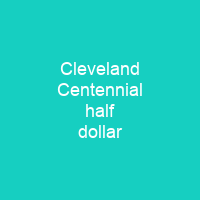The Cleveland Centennial Half Dollar: A Coin with a Controversial Past
Imagine stepping into the bustling streets of early 1936 Cleveland, where the air was thick with anticipation and excitement. The city had just celebrated its centennial year, marking 100 years since it first incorporated as an official city. But what if I told you that this celebration wasn’t just about past achievements? It was also a clever business venture wrapped in patriotic fervor.
Who Was Behind the Cleveland Centennial Half Dollar?
Thomas G. Melish, a prominent businessman from Cincinnati and a coin collector himself, saw an opportunity to make a profit while honoring his hometown’s history. He lobbied Congress for permission to mint commemorative coins, which would be sold at a premium price later on. This strategy was not without its critics; some even called it a ‘coin-collector’s racket.’ But Melish was undeterred and managed to get the Cleveland Centennial half dollar authorized by Congress.
The Design and Its Controversies
Enter Brenda Putnam, whose design for the coin would become a subject of debate. The obverse featured Moses Cleaveland, the founder of Cleveland, with his portrait surrounded by inscriptions. On the reverse, a map of the Great Lakes region was depicted, with nine stars representing major cities, including Cleveland, which received the largest star and a compass symbol.
Was this design meant to signify Cleveland’s industrial prowess? Or was it simply a clever marketing move?
The Mintage and Distribution
With authorization in hand, Melish ordered 25,000 coins from the Philadelphia Mint. These were distributed at $1.50 each through his office in Cincinnati. The initial sales were brisk, but many coins remained unsold or were hoarded by dealers. By 1941, some clubs had even countermarked these coins without permission.
Was Melish’s strategy a success? Or did the coin become just another piece of numismatic history?
The Legacy and Current Value
Today, the Cleveland Centennial half dollar is considered common, with prices ranging from $100 to $230 depending on condition. Exceptional specimens can fetch up to $4,700. This coin serves as a reminder of how commemorative coins can blend historical significance with commercial interests.
Do you think the Cleveland Centennial half dollar was just a clever business move or an important piece of numismatic history?

The Cleveland Centennial half dollar stands as a testament to the intersection of commerce and commemoration. It was more than just a coin; it was a business venture wrapped in patriotic symbolism. Whether you see it as a clever marketing ploy or an important piece of numismatic history, one thing is clear: this coin has left its mark on American numismatics.
You want to know more about Cleveland Centennial half dollar?
This page is based on the article Cleveland Centennial half dollar published in Wikipedia (retrieved on November 29, 2024) and was automatically summarized using artificial intelligence.







